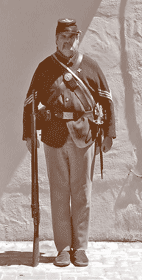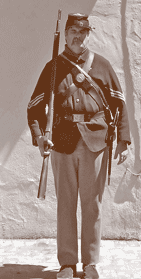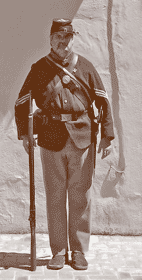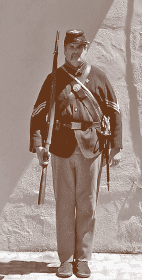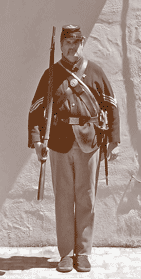The Manual of Arms was the basic manual for training troops. Old soldiers remembered it well and could still perform the movements even in their old age. William Hardees Manual was first used and eventually was revised to become Caseys Manual. But the boys who joined up first in 1861 predominantly used Hardees Manual throughout the war.
Commands are always given in two parts: the command of preparation and the command of execution. The command of preparation is the first part of the entire command. It’s purpose is to prepare the soldiers in the ranks for the subsequent movement. The command of execution (shown below in italics) is given to execute the movement. Emphasis when giving the command is on the command of execution and a short pause (approximately 1 second) should exist between the two parts.
Watch the training video below to understand the basics of “Stacking Arms”.
Orders for the Manual of Arms:
(The Manual of Arms is typically cycled through the “Shoulder Arms” position*)
*The order of these commands may vary depending on the commander.
“Attention – Company!”
“Shoulder – Arms!”
“Right Shoulder Shift – Arms!”
“Shoulder – Arms!”
“Present – Arms!”
“Shoulder – Arms!”
“Support – Arms”
“Shoulder – Arms!”
“Trail – Arms!”
“Shoulder – Arms!”
“Secure – Arms!”
“Shoulder – Arms!”
“Arms – Port!”
“Shoulder – Arms!”
“Charge – Bayonet!”
“Order – Arms!”
“Rest on – Arms!”
“Parade – Rest!”
“In Place – Rest!”
Forming the Company in Two Ranks
Upon the order to “Fall-in”, the company will fall-in, in one rank with the tallest soldier on the right and shortest on the left, with the 1st corporal positioned at the beginning of the line as the tallest soldier. The 1st Sergeant will then give the commands, “Attention – Company!” —”Shoulder – Arms!” —”Forming Company in two ranks!” — “Right Face! – March!” At the command to Right-Face, the tallest private will About-Face and take one pace forward, while the rest of the line waits for the order to march. At the order to “March!”, the files will then fill in sequentially to create two ranks with the tallest private moving behind the 1st corporal, and the tallest man of each file pair in the rear rank. The 1st Sergeant will then command, “Company – Front” and place the corporals accordingly. Then he will command, “In Each Rank, Count – Two!” Once counted off in twos, the Company will then be considered formed.
Morning Parade
The Company having been formed in two ranks and At-the-Shoulder, the 1st Sergeant shall command, “To the Rear, Open Order – March!” After the command of preparation, the 2nd Sergeant takes four paces to the rear. At “March!”, the rear rank falls back to the line established by the 2nd Sergeant. The sergeants of the Company will automatically post themselves 2 paces in front of the Company facing the 1st Sergeant once the ranks have been opened. The 1st Sergeant will then command, “Support – Arms!”
Roll Call
The 1st Sergeant, posted 4 paces in front of the company, will then call the roll in descending rank. Each soldier, upon hearing his name called, will go to the Shoulder-Arms position, report, and then return to the Order-Arms position. The 1st Sergeant, upon completing the roll, will return the sergeants to their places in line.
General
Morning parade will be held each morning promptly at 8:00 a.m. (reenactments can vary). Saturday mornings, an N.C.O. call will be held prior to the parade so that the roles that each N.C.O. shall play during the parade and inspection can be defined for each day.
Inspection of Troops
The ranks already having been opened, the 1st Sergeant shall post himself 4 paces in front of the center of the company. He will then give the commands, ”Attention, Company! — Inspection, Arms!” The men in the ranks, except the inspecting NCOs, will fix bayonets and spring rammers and return to the Order-Arms position. The 1st Sergeant will then post the inspecting NCOs 2 paces in front of the center of the company, facing forward. He will then order, “Open – Boxes!” and direct the inspectors to conduct the inspection.
Weapons Inspection
The inspecting NCO of each rank will pass sequentially down the line, inspecting each man’s musket. He will follow this procedure:
Trigger / hammer
1. Bring the hammer to half-cock and squeeze the trigger. If the hammer falls, the weapon has failed.
2. Bring the hammer to full-cock and apply pressure to it using the thumb. If the hammer falls to half-cock, the weapon fails.
3. Check the tightness of the hammer screw and the cleanliness of the nipple.
Rammer
Lightly drop the rammer on the breech. If no metallic “ping” is heard, the weapon fails
Gear Inspection
Reaching the end of the line, the inspecting officer will return to the right of the company, passing behind the rank he is responsible for inspecting. At this time, he will inspect the rest of the men’s gear following this procedure:
Canteens
All soldiers, will have a full canteen or will be prevented from taking the field.
Bayonet Scabbards & Knives
All knives must be tied-in or removed prior to taking the field. The tips of the scabbards must be intact or the bayonet will not be allowed on the field.
Cartridge boxes
Cartridge boxes must be full. Staples, paper clips, metal of any kind, or live rounds will result in immediate banishment from the field.
Report
Upon completing the inspection, the inspecting NCOs will once again post themselves 2 paces in front of the center of the company, facing the 1st Sergeant. They will then report, “Front (or rear) rank inspected and all passed.” If there is a failure/discrepancy, the report must reflect it so that corrective action can occur. The 1st Sergeant shall then dismiss the inspectors back to their places in line. He will then order, “Close Boxes! — Unfix Bayonets!” and will provide assistance for those that need it.
Capping Off
The 1st Sergeant will command, “Shoulder – Arms! Prime!” and post the 2nd Sergeant 2 paces in front of the center of the company, facing forward. He will then instruct the 2nd Sergeant to inspect the rear rank. One cap will be fired by each soldier into the ground. If no movement is observed when the cap is fired, a second one will be fired. If the second discharge fails to produce movement, the weapon fails.
Report
Upon completion of capping off, the 2nd Sergeant will again post himself opposite the center of the company, facing the 1st Sergeant. He will report, “Rear rank inspected and all passed.” If there is a failure/discrepancy, the report must reflect it so that corrective action can occur. The 1st Sergeant will then order him back to his post.
Noncomissioned officers were a very important part of the command structure. These roles are defined below:
The Corporal
“They are selected from the most intelligent privates who have been longest in service and who are noted for their military appearance and attention to duty.”
1) Reports to and takes orders from the 1st Sergeant.
2) Knows / instructs the school of the soldier.
3) Corporal of the Guard
4) Corporal of the Police
5) Familiar with the sergeants’ duties.
6) Examples of neatness, cleanliness, and promptness.
7) Responsible for small details on fatigue, police, and garrison duty and equipment used.
8) Firm and fair but not arrogant; obedience
9) Perhaps in charge of a mess.
10) Reports discipline problems to the 1st Sergeant.
(See Kautz’s NCO Guide for full Corporal duties description)
The Sergeant
1) All of the duties of the corporal
2) Commands work, guard, police, and fatigue details.
3) Fair and impartial
4) Responsible for squad / detail equipment.
5) Preliminary instruction of the troops.
6) File closers – keeps men in ranks
7) Discourage straggling.
8) Discipline
9) Fill canteens / monitor ration consumption.
10) Knows the duties of the 1st Sergeant.
11) Commands a platoon if necessary.
(See Kautz’s NCO Guide for full Sergeant duties description)
The First Sergeant
1) Keeps track of the clothing accounts.
2) Arranges all details.
3) Keeps a roster of details.
4) Leads large details.
5) Parades details to the Sergeant Major.
6) Morning, absentee, sick reports.
7) Supervises the company cooks.
8) Forms the company.
9) Keeps the roster.
10) Does roll call.
11) Responsible for all company equipment.
12) Supervises the company police.
13) Superintends the company clerk or acts as clerk in the absence of one.
14) Gets orders directly from the commanding officer and/or company commander.
15) Immediate supervision of the company.
16) Goes to orderly and NCO calls.
17) Discipline in the ranks and in camp.
18) Company safety officer.
19) Acts as Company Quartermaster, Armorer, and Commissary.
20) Has prominent role in Dress Parade.
21) Commands the company if necessary.
(See Kautz’s NCO Guide for full 1st Sergeant duties description)
